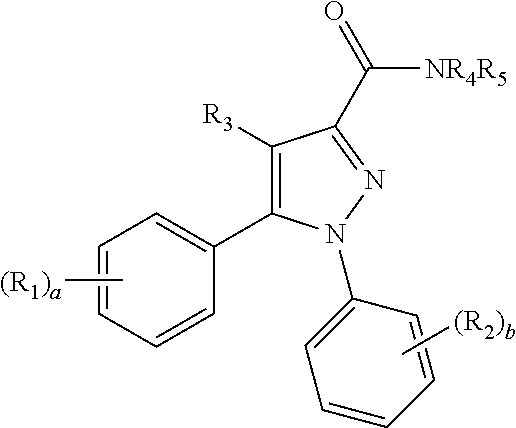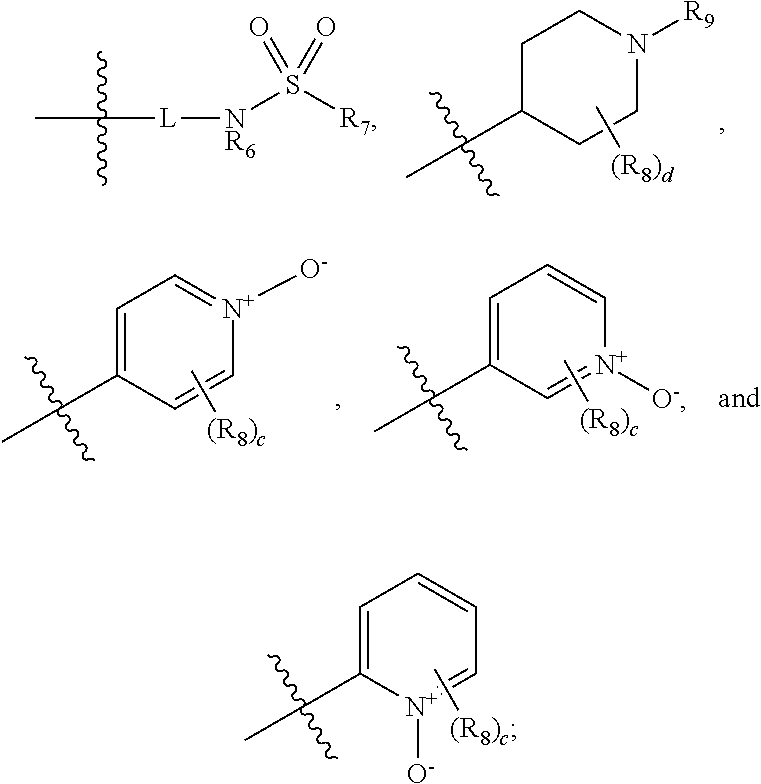Pyrazole derivatives as cannabinoid receptor 1 antagonists
a cannabinoid receptor and antagonist technology, applied in the field of pyrazole derivatives as cannabinoid receptor 1 antagonists, can solve the problems of rimonabant being withdrawn from european markets and denied fda approval, and achieve the effect of maintaining the ability to block the cb1 receptor and minimizing cns-related side effects
- Summary
- Abstract
- Description
- Claims
- Application Information
AI Technical Summary
Benefits of technology
Problems solved by technology
Method used
Image
Examples
example 1
Synthesis
General Procedure for the Oxidation of (pyridinyl)-1H-pyrazole-3-carboxamides to (pyridinium oxide)-1H-pyrazole-3-carboxamides.
[0182]To a solution of (pyridin-4-yl)-1H-pyrazole-3-carboxamide in dichloromethane was added to 77% m-CPBA (1.8 eq). The reaction mixture was stirred for 16 h. Dichloromethane and saturated sodium bicarbonate solution was added. The layers were separated and the aqueous layer was extracted twice with dichloromethane. The combined organic layers were dried with magnesium sulfate. The solution was then filtered and concentrated in vacuo. The crude reaction material was then purified by silica gel column chromatography using 0-50% CMA 80 / ethyl acetate to yield pure pyridinium oxide.
[0183]4-[5-(4-chlorophenyl)-1-(2,4-dichlorophenyl)-4-methyl-1H-pyrazole-3-amido]pyridin-1-ium-1-olate: 1H NMR (300 MHz, CHLOROFORM-d) d ppm 2.41 (s, 3H) 7.05-7.12 (m, 2H) 7.24-7.37 (m, 4H) 7.47 (s, 1H) 7.66-7.73 (m, 2H) 8.16 (d, J=7.54 Hz, 2H) 9.07 (s, 1H).
[0184]5-[5-(4-chlo...
example 2
Analysis
[0250]All compounds were characterized by H1 NMR and evaluated using a calcium mobilization assay. Each compound was pharmacologically characterized using a functional fluorescent CB1 activated Gαq16-coupled intracellular calcium mobilization assay in CHO-K1 cells as has been previously described and apparent affinity (Ke) values were determined. See Zhang et al., J. Med. Chem. 2010, 53, 7048, which is incorporated herein by reference. Further characterization of select compounds was performed using radioligand displacement of [3H]1 and equilibrium dissociation constant (Ki) values were determined. Selectivity of these compounds at CB1 versus CB2 was also determined by obtaining Ki values at either receptor using displacement of [3H]CP55940 in membranes of CHO-K1 cells over-expressing either receptor. Data reported are average values from 3-6 measurements.
[0251]
TABLE 1Alkyl pyridinium salts and N-oxide derivatives via Scheme 1RKe CB1 (μM)0.117>101.390.3848.411.200.9808.594.5...
PUM
| Property | Measurement | Unit |
|---|---|---|
| temperature | aaaaa | aaaaa |
| time | aaaaa | aaaaa |
| sizes | aaaaa | aaaaa |
Abstract
Description
Claims
Application Information
 Login to View More
Login to View More - R&D
- Intellectual Property
- Life Sciences
- Materials
- Tech Scout
- Unparalleled Data Quality
- Higher Quality Content
- 60% Fewer Hallucinations
Browse by: Latest US Patents, China's latest patents, Technical Efficacy Thesaurus, Application Domain, Technology Topic, Popular Technical Reports.
© 2025 PatSnap. All rights reserved.Legal|Privacy policy|Modern Slavery Act Transparency Statement|Sitemap|About US| Contact US: help@patsnap.com



